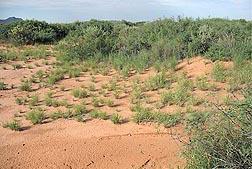This page has been archived and is being provided for reference purposes only. The page is no longer being updated, and therefore, links on the page may be invalid.
| Read the magazine story to find out more. |
|
|
|
|
Climate Changes Help Grass Come Back to U.S. Rangelands
By Ann PerryAugust 3, 2012
Global climate changes could help some shrub-dominated deserts revert to ecosystems that support the growth and establishment of grasslands, U.S. Department of Agriculture (USDA) studies suggest. These findings indicate that sufficient increased precipitation over a sequence of years—and carefully managed grazing—could help keep woody plants in check in the U.S. Southwest.
Agricultural Research Service (ARS) ecologist Debra Peters works at the ARS Jornada Experimental Range in Las Cruces, N.M. Peters and several other researchers used plant distribution maps compiled in the 1800s to compare changes in plant distribution with precipitation, and to identify long-term trends in desertification.
ARS is USDA's chief intramural scientific research agency, and these findings support the USDA priority of responding to climate change.
After the team pinpointed the changes in vegetation distribution over the past 150 years, they accessed data collected since 1989 by collaborators with the Jornada Basin Long Term Ecological Research project. Data were available from five desert ecosystem types: upland grasses, playa grasslands, and mesquite, creosotebush, and tarbush shrublands.
Then the scientists compared the changes in herbaceous and woody species since 1989 to changes after a sequence of dry and average rainfall years from 1994 to 2003, and after a series of wet years from 2004 to 2008.
During the wet years, all study plots showed an increase in plant production, primarily via an increase in herbaceous plants. This increase was the highest on upland grasslands and mesquite shrublands, which were the sandiest sites. In addition, other indicators of plant production and diversity were significantly higher in upland grasses, mesquites, and tarbushes during the wet period than the dry period.
Peters thinks the wet years prompted a change in plant-soil-water interactions, which eventually supported the growth and establishment of grasses.
The study was published last year in Global Change Biology.
Read more about this research in the August 2012 issue of Agricultural Research magazine.

